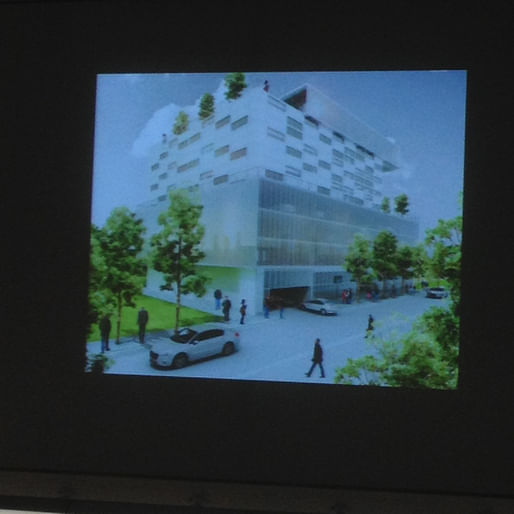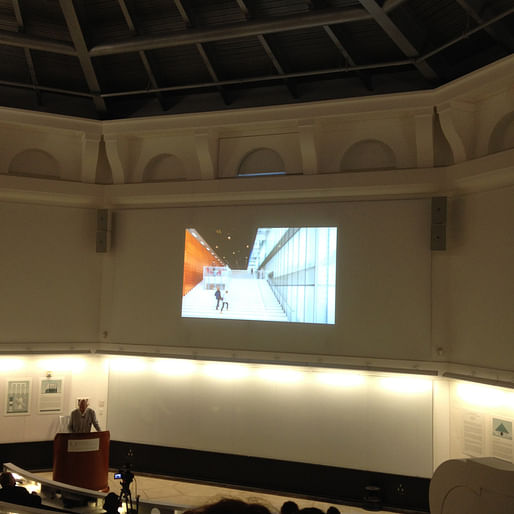
 This past Wednesday, Enrique Norten of TEN Arquitectos kicked off the lecture series season at the University Of Miami School Of Architecture. Once again sponsored by Tecnoglass, this year's focus is on Miami and the Tropical World. Dean Rodolphe el-Khoury explains to the audience that academic term theme celebrates the rapidly evolving city of Miami and how it responds to its locale. He describes three important elements of Miami and the Tropical World:
This past Wednesday, Enrique Norten of TEN Arquitectos kicked off the lecture series season at the University Of Miami School Of Architecture. Once again sponsored by Tecnoglass, this year's focus is on Miami and the Tropical World. Dean Rodolphe el-Khoury explains to the audience that academic term theme celebrates the rapidly evolving city of Miami and how it responds to its locale. He describes three important elements of Miami and the Tropical World:
1. How the location of the tropics deals with modern and vernacular traditions, and how these traditions are rediscovered / repurposed
2. The longitudinal comparison of cities along the "tropical belt" (tropics and subtropics zones) and the shared challenges these cities face such as climate change, sea level rise, etc...
3. Looking at development and the influence that international architects bring on these cities.
The third point relates directly to Norten, in which el-Khoury describes as not a Mexican architect or American architect but an international one.
 Norten first gives a brief introduction on his views on architecture in the 21st century. He believes that the 20th century viewed architecture as an object but moving forward the field has hit a "dead end" of sorts causing architects to turn around and consider new opportunities and new challenges. He further states that today, architecture is not about being the best, or the most responsive, but about being the weirdest. "Is being weirder better?" he rhetorically asks the crowd; his stance is that it isn't. Unfortunately he gives no examples of the weirdness in architecture today; he hints that in past lectures he has but has decided to protect the identities of these practices by removing the slides.
Norten first gives a brief introduction on his views on architecture in the 21st century. He believes that the 20th century viewed architecture as an object but moving forward the field has hit a "dead end" of sorts causing architects to turn around and consider new opportunities and new challenges. He further states that today, architecture is not about being the best, or the most responsive, but about being the weirdest. "Is being weirder better?" he rhetorically asks the crowd; his stance is that it isn't. Unfortunately he gives no examples of the weirdness in architecture today; he hints that in past lectures he has but has decided to protect the identities of these practices by removing the slides.
Norten then describes his work in three categories: landscape, infrastructure, and public space. He presents several projects for each. Landscape in terms of effecting, or changing the terrain / territory through his architecture, Infrastructure as a way infuse the civic structure and Public Space as a means to connect his work to the community. Ironically, although Norten segregates his projects this way, the majority of the work presented encompasses all aspects. One in particular, and one of the cleverest projects shown during the lecture was the Acapulco City Hall. 
The site chosen runs parallel to the beach, which he refers to as the real public space in Mexico. It serves as the great equalizer because the beach is a place where no one cares about your profession, your status in society, your race, but just presents a space for all to enjoy. He treats the city hall as a group of segmented buildings which is often not the case in government buildings. Instead of lumping all the program into one tall skyscraper or superblock, each building is now responsible for its own resources and utilities. The two things uniting these compartments are the lower level plaza and a large canopy that hovers them. The plaza below helps create a porous environment, allowing the building to be used as its own public space and protected from the elements. The structure can then be used by more than just bureaucrats, but by the community 24/7 three hundred sixty five days a year. 
At the end of the lecture, Norten is asked where he stands in the position of weirdness. He mentions his main concern is how little the weirdness brings to architecture and is annoyed only when there is very little architecture found within it. He comments that he doesn't use certain materials just for the sake of using them, but rather only when appropriate or when they fit to a certain project. He concludes by saying that the modern movement is still in its infancy and has a "ways to go", but there will always be great opportunities to succeed without getting into tremendous gymnastics.

This blog gives a sneak peak into the architecture world at the University of Miami. What began as an experiment following one group of incoming graduate students through their first semester of design, has morphed into a window of the school of architecture through this professor's eyes. I will try to post as often as possible.
1 Comment
" He believes that the 20th century viewed architecture as an object but moving forward the field has hit a "dead end" of sorts causing architects to turn around and consider new opportunities and new challenges."
" He concludes by saying that the modern movement is still in its infancy and has a "ways to go"
How much more can one go when stuck in a dead end?
Block this user
Are you sure you want to block this user and hide all related comments throughout the site?
Archinect
This is your first comment on Archinect. Your comment will be visible once approved.